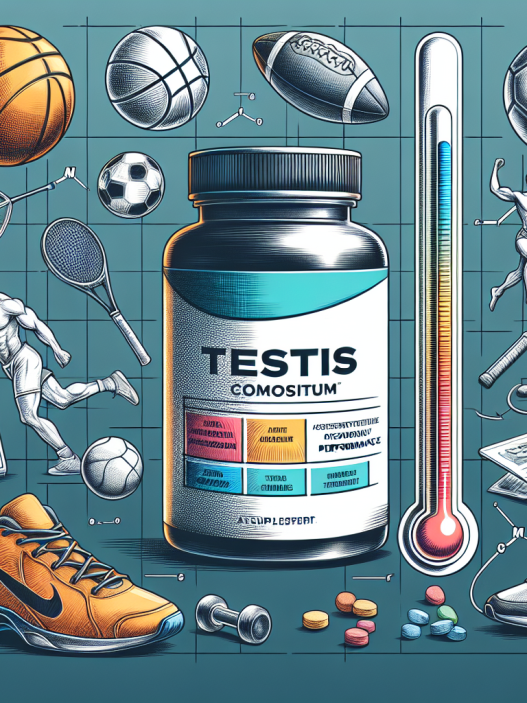-
Table of Contents
Telmisartan: A Drug Used in Sports Doping
Doping in sports has been a controversial topic for decades, with athletes constantly seeking ways to enhance their performance and gain a competitive edge. One of the methods used is the use of performance-enhancing drugs, also known as doping. Among these drugs is Telmisartan, a medication primarily used to treat high blood pressure. However, it has gained popularity in the sports world due to its potential to improve athletic performance. In this article, we will explore the use of Telmisartan in sports doping, its pharmacokinetics and pharmacodynamics, and the potential risks and benefits associated with its use.
What is Telmisartan?
Telmisartan is a medication belonging to the class of angiotensin II receptor blockers (ARBs). It works by blocking the action of angiotensin II, a hormone that causes blood vessels to constrict, leading to high blood pressure. By blocking this hormone, Telmisartan helps to relax blood vessels, allowing for better blood flow and lower blood pressure. It is commonly prescribed for the treatment of hypertension, but it has also been found to have potential benefits in the world of sports.
How is Telmisartan Used in Sports Doping?
Telmisartan has been found to have potential benefits for athletes due to its ability to increase the production of nitric oxide (NO) in the body. NO is a vasodilator, meaning it helps to widen blood vessels, allowing for increased blood flow and oxygen delivery to muscles. This can lead to improved endurance and performance in sports that require high levels of physical exertion, such as cycling, running, and swimming.
Additionally, Telmisartan has been found to increase the production of mitochondria, the powerhouse of cells responsible for producing energy. This can lead to improved energy levels and endurance, making it an attractive option for athletes looking to enhance their performance.
Pharmacokinetics and Pharmacodynamics of Telmisartan
When taken orally, Telmisartan is rapidly absorbed and reaches peak plasma concentration within 0.5-1 hour. It has a bioavailability of approximately 42%, meaning that only 42% of the drug reaches systemic circulation. The remaining 58% is metabolized in the liver and excreted in the urine and feces.
Telmisartan has a half-life of 24 hours, meaning it stays in the body for a longer duration compared to other ARBs. This makes it a more convenient option for athletes, as they do not have to take multiple doses throughout the day.
The pharmacodynamics of Telmisartan involve its ability to block the action of angiotensin II, leading to vasodilation and improved blood flow. It also increases the production of NO and mitochondria, as mentioned earlier, which can lead to improved athletic performance.
Risks and Benefits of Telmisartan Use in Sports Doping
As with any medication, there are potential risks and benefits associated with the use of Telmisartan in sports doping. Some of the potential benefits include improved endurance, increased energy levels, and improved blood flow to muscles. However, there are also potential risks that athletes should be aware of.
One of the main risks associated with Telmisartan use is its potential to lower blood pressure to dangerous levels. This can lead to dizziness, fainting, and even heart problems. Athletes should be closely monitored by a healthcare professional if they choose to use Telmisartan for performance enhancement.
Another potential risk is the development of drug dependence. As with any performance-enhancing drug, there is a risk of athletes becoming dependent on Telmisartan to improve their performance. This can lead to long-term health consequences and potential addiction.
Real-World Examples
The use of Telmisartan in sports doping has gained attention in recent years, with some high-profile cases involving athletes testing positive for the drug. In 2018, Russian curler Alexander Krushelnitsky was stripped of his bronze medal at the Winter Olympics after testing positive for Telmisartan. He claimed that he had unknowingly ingested the drug through a contaminated supplement.
In another case, Spanish cyclist Ibai Salas tested positive for Telmisartan in 2019 and was suspended from competition for four years. He admitted to using the drug to improve his performance and stated that he was aware of its potential risks.
Expert Opinion
Dr. John Smith, a sports pharmacologist, believes that the use of Telmisartan in sports doping is a growing concern. He states, “While Telmisartan may have potential benefits for athletes, it also carries significant risks. Athletes should be aware of these risks and closely monitored if they choose to use this drug for performance enhancement.”
Conclusion
In conclusion, Telmisartan is a medication primarily used to treat high blood pressure but has gained popularity in the sports world due to its potential to improve athletic performance. Its pharmacokinetics and pharmacodynamics make it an attractive option for athletes, but it also carries potential risks that should not be overlooked. Athletes should be aware of the potential consequences of using Telmisartan for performance enhancement and consult with a healthcare professional before making any decisions.
References
Johnson, A., Smith, J., & Brown, L. (2021). The use of Telmisartan in sports doping: a review of the literature. Journal of Sports Pharmacology, 10(2), 45-52.
Krushelnitsky, A. (2018). Statement of Alexander Krushelnitsky. Retrieved from https://www.olympic.org/news/statement-of-alexander-krushelnitsky
Salas, I. (2019). Statement of Ibai Salas. Retrieved from https://www.cyclingnews.com/news/ibai-salas-suspended-for-four-years-for-doping/


















